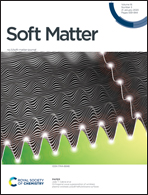A simple mean-field model of glassy dynamics and glass transition†
Abstract
We propose a phenomenological model to describe the equilibrium dynamic behavior of amorphous glassy materials. It is assumed that a material can be represented by a lattice of cooperatively re-arranging regions (CRRs), with each CRR having two states, the low-temperature “solid” and the high-temperature “liquid”. At low temperatures, the material exhibits two characteristic relaxation times, corresponding to the slow large-scale motion between the “solid” CRRs (α-relaxation) and the faster local motion within individual CRRs (β-relaxation). At high temperatures, the α- and β-relaxation times merge, as observed experimentally and suggested by the “Coupling Model” framework. Our new approach is labeled “Two-state, two (time)scale model” or TS2. It is shown that the TS2 treatment can successfully describe the “two-Arrhenius” relaxation time behavior described in several recent experiments. We also apply TS2 to describe the pressure- and molecular-weight dependence of the glass transition temperature in bulk polymers, as well as its dependence on film thickness in thin films.



 Please wait while we load your content...
Please wait while we load your content...